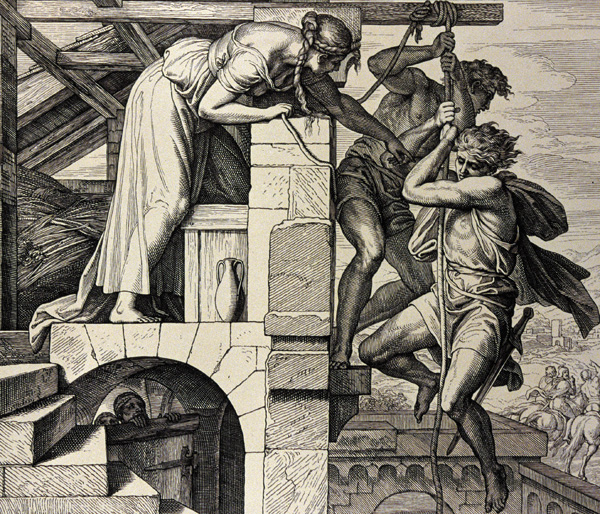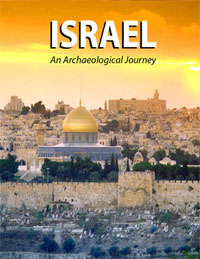In the Book of Joshua, Rahab (a heroine nonetheless known as “Rahab the Harlot”) assisted two Israelite spies in escaping out a window and down the city wall of Jericho. Who was Rahab in the Bible? A Biblical prostitute or just an innkeeper? Did she live on the wall of Jericho or within it, in what is known to archaeologists as a casemate wall? Anthony J. Frendo addresses these questions about the life of Rahab in the Bible in the September/October 2013 issue of Biblical Archaeology Review. Whether or not she was a Biblical prostitute, archaeology may at least be able to answer whether Rahab lived on or in the casemate wall of Jericho.

Rahab the harlot? It may be a surprise to some readers, but Biblical prostitutes were commonly mentioned in the text. What was the profession of Rahab in the Bible? Here, she assists Israelite spies down what may be a casemate wall, within which her home may have been located. Image: CCI/The Art Archive at Art Resource, NY.
Rahab helped two Israelites when they came to spy out the land of Jericho. She hid them on her roof when the king came for them. When the coast was clear, Rahab let the spies down by a rope through the window.
So what do we know about Rahab the harlot? Was she a Biblical prostitute? The Biblical text identifies her as a zônāh, a prostitute (Joshua 2:1), but she seems more like a landlady. Indeed, the first-century C.E. historian Josephus reports that she kept an inn. The consonants that comprise the word “prostitute” in Hebrew are znh, which are the same consonants that comprise the Hebrew word for a female who gives food and provisions. The text doesn’t describe Rahab’s profession negatively, as one might expect from a description of Biblical prostitutes. The lifestyle of Rahab in the Bible continues to elude us. Whether we remember her as Rahab the harlot or innkeeper, she was a Biblical heroine.

We may be able to understand the chronology of the story by examining whether Rahab lived on the wall of Jericho or in the city’s casemate. The structure of the city wall varied in different periods in ancient Israel. In the Late Bronze Age, the time in which the story of Rahab in the Bible was set, thick defensive walls were common; people could conceivably have lived on them. During the Iron Age II period (sixth century B.C.E.), when the Book of Joshua was thought to have been edited, Israelite settlements were often surrounded by a casemate wall, which was comprised of two parallel walls with periodic perpendicular walls, forming casemates, or rooms, that people lived within. Analyzing the Hebrew words for “within the wall,” which described the residence of Rahab the harlot, along with the chronology of defensive construction in ancient Israel, Frendo suggests that Rahab lived on the wall. Frendo proposes that an editor changed the Hebrew to reflect that Rahab lived in the wall of Jericho within a casemate wall, rather than on top of a thick defensive wall, to make the text understandable to people in Israel during the late Iron Age.
BAS Library Members: Read the full article “Was Rahab Really a Harlot?” by Anthony J. Frendo as it appears in the September/October 2013 issue of Biblical Archaeology Review.Not a BAS Library or All-Access Member yet? Join today.
To learn more about Biblical women with slighted traditions, take a look at the Bible History Daily feature Scandalous Women in the Bible, which includes articles on Mary Magdalene and Jezebel.
This Bible History Daily feature was originally published on September 23, 2013.
Get more biblical Archaeology: Become a Member
The world of the Bible is knowable. We can learn about the society where the ancient Israelites, and later Jesus and the Apostles, lived through the modern discoveries that provide us clues.
Biblical Archaeology Review is the guide on that fascinating journey. Here is your ticket to join us as we discover more and more about the biblical world and its people.
Each issue of Biblical Archaeology Review features lavishly illustrated and easy-to-understand articles such as:
• Fascinating finds from the Hebrew Bible and New Testament periods
• The latest scholarship by the world's greatest archaeologists and distinguished scholars
• Stunning color photographs, informative maps, and diagrams
• BAR's unique departments
• Reviews of the latest books on biblical archaeology
The BAS Digital Library includes:
• 45+ years of Biblical Archaeology Review
• 20+ years of Bible Review online, providing critical interpretations of biblical texts
• 8 years of Archaeology Odyssey online, exploring the ancient roots of the Western world in a scholarly and entertaining way,
• The New Encyclopedia of Archaeological Excavations in the Holy Land
• Video lectures from world-renowned experts.
• Access to 50+ curated Special Collections,
• Four highly acclaimed books, published in conjunction with the Smithsonian Institution: Aspects of Monotheism, Feminist Approaches to the Bible, The Rise of Ancient Israel and The Search for Jesus.
The All-Access membership pass is the way to get to know the Bible through biblical archaeology.
The post Rahab the Harlot? appeared first on Biblical Archaeology Society.


0 Commentaires